NCERT Solutions Class 10th Chapter 13: Surface Areas And VolumesExercise 13.1Unless stated otherwise, take π = 22/7 1. 2 cubes each of volume 64 cm3 are joined end to end. Find the surface area of the resulting cuboid. Solution 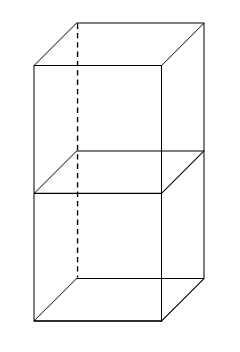
Volume of 1 cube = 64 cm3 a3 = 64 a = 4 cm Length of the side of each cube = 4 cm Length of the cuboid when two cubes are joined = a = 4 cm Breadth of the cuboid when two cubes are joined = a = 4 cm Height of the cuboid when two cubes are joined = 2a = 8 cm Total surface area of the cube = 2(lb + bh + hl) = 2(4 × 4 + 4 × 8 + 8 × 4) = 2(16 + 32 + 32) = 2(80) = 160 cm2 2. A vessel is in the form of a hollow hemisphere mounted by a hollow cylinder. The diameter of the hemisphere is 14 cm and the total height of the vessel is 13 cm. Find the inner surface area of the vessel. Solution 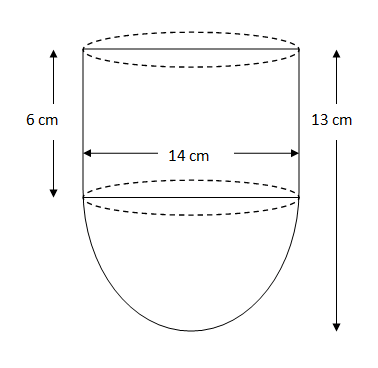
Radius of the cylinder and the hemisphere = 14/2 = 7 cm Curved Surface Area of the cylinder = 2πrh = 2 × 22/7 × 7 × 6 = 264 cm2 Curved Surface Area of the hemisphere = 2πr2 = 2 × 22/7 × 7 × 7 = 308 cm2 Inner surface area of the vessel = CSA of cylinder + CSA of hemisphere = 264 + 308 = 572 cm2 3. A toy is in the form of a cone of radius 3.5 cm mounted on a hemisphere of same radius. The total height of the toy is 15.5 cm. Find the total surface area of the toy. Solution 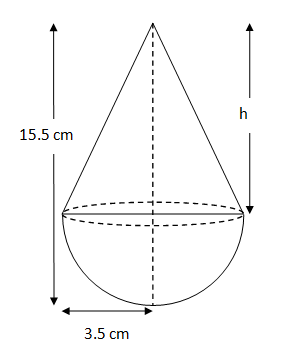
Height of the cone = h = Height of toy - Radius of hemisphere = 15.5 - 3.5 = 12 cm Slant height of the cone = l = √(h2 + r2) = √(122 + 3.52) = √(144 + 12.25) = √(156.25) = 12.5 cm Curved Surface Area of the cone = πrl = 22/7 × 3.5 × 12.5 = 137.5 cm2 Curved Surface Area of the hemisphere = 2πr2 = 2 × 22/7 × 3.5 × 3.5 = 77 cm2 Total surface area of the toy = CSA of the cone + CSA of the hemisphere = 137.5 + 77 = 214.5 cm2 4. A cubical block of side 7 cm is surmounted by a hemisphere. What is the greatest diameter the hemisphere can have? Find the surface area of the solid. Solution 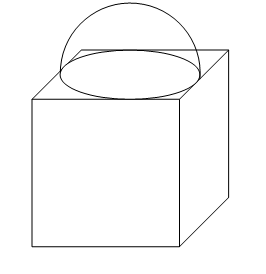
Since, the length of each side of the cube is 7 cm. Therefore, the maximum possible diameter for the hemisphere is 7 cm. Curved Surface Area of the Hemisphere = 2πr2 = 2 × 22/7 × 7/2 × 7/2 = 77 cm2 Area of the base of the hemisphere = πr2 = 22/7 × 7/2 × 7/2 = 38.5 cm2 Surface Area of the square = 6a2 = 6 × 72 = 6(49) = 294 cm2 Total surface area of the given solid = Surface Area of Cube + CSA of hemisphere - Area of the base of Hemisphere = 294 + 77 - 38.5 = 294 + 38.5 = 332.5 cm2 5. A hemispherical depression is cut out from one face of a cubical wooden block such that the diameter l of the hemisphere is equal to the edge of the cube. Determine the surface area of the remaining solid. Solution 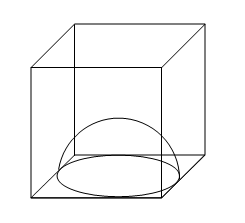
Curved Surface area of the Hemisphere = Curved Surface area of the Hemisphere = 2πr2 = 2 × 22/7 × l/2 × l/2 = 11l2/7 sq. units Area of the base of the hemisphere = πr2 = 22/7 × l/2 × l/2 = 11l2/14 sq. units Surface Area of the cube = 6l2 sq. units Total surface area of the solid = Surface Area of the cube + CSA of hemisphere - Area of base of hemisphere = 6l2 + 11l2/7 + 11l2/14 = (154l2 + 22l2 + 11l2)/14 = (187l2)/14 sq. units 6. A medicine capsule is in the shape of a cylinder with two hemispheres stuck to each of its ends (see Fig. 13.10). The length of the entire capsule is 14 mm and the diameter of the capsule is 5 mm. Find its surface area. 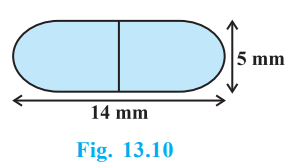
Solution 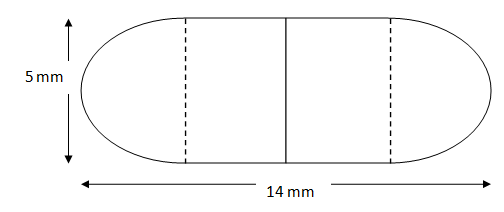
Length of the cylindrical part = Length of capsule - 2 × Radius of the hemisphere at end = 14 - 5 = 9 mm Curved Surface area of cylinder = 2πrh = 2 × 22/7 × 5/2 × 9 = 990/7 mm2 Curved Surface area of one of the hemispheres = 2πr2 = 2 × 22/7 × 5/2 × 5/2 = 275/7 mm2 Curved Surface area of both hemispheres = 2 × 275/7 = 550/7 mm2 Total surface area of the capsule = CSA of both hemispheres + CSA of the cylinder = 550/7 + 990/7 = 1540/7 = 220 mm2 7. A tent is in the shape of a cylinder surmounted by a conical top. If the height and diameter of the cylindrical part are 2.1 m and 4 m respectively, and the slant height of the top is 2.8 m, find the area of the canvas used for making the tent. Also, find the cost of the canvas of the tent at the rate of Rs 500 per m2. (Note that the base of the tent will not be covered with canvas.) Solution 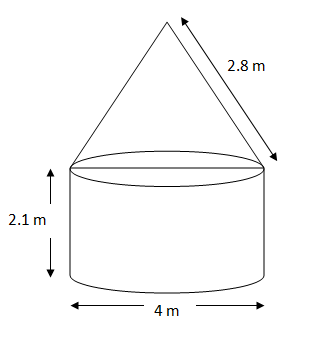
Curved Surface Area of the Conical top = πrl = 22/7 × 4/2 × 2.8 = 17.6 m2 Curved Surface Area of the Cylindrical bottom = 2πrh = 2 × 22/7 × 4/2 × 2.1 = 26.4 m2 Total Canvas used = CSA of cone + CSA of Cylinder = 17.6 + 26.4 = 44 m2 Cost of 1 m2 of canvas = Rs 500 Cost of 44 m2 of canvas = 500 × 44 = Rs 22000 Hence, the cost of the canvas for the tent is Rs 22000. 8. From a solid cylinder whose height is 2.4 cm and diameter 1.4 cm, a conical cavity of the same height and same diameter is hollowed out. Find the total surface area of the remaining solid to the nearest cm2. Solution 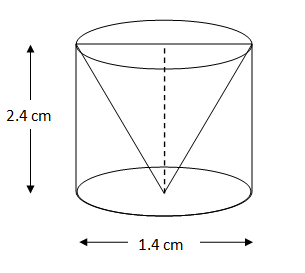
Radius of the cylinder = 1.4/2 = 0.7 cm Slant height of the conical cavity = l = √(h2 + r2) = √(2.42 + 0.72) = √(5.76 + 0.49) = √(6.25) = 2.5 cm Curved Surface Area of the cone = πrl = 22/7 × 0.7 × 2.5 = 5.5 cm2 Curved Surface Area of the cylinder = 2πrh = 2 × 22/7 × 0.7 × 2.4 = 10.56 cm2 Area of the base of cylinder = πr2 = 22/7 × 0.7 × 0.7 = 1.54 cm2 Total Surface Area of the remaining solid = CSA of the cone + CSA of the cylinder + Area of base of cylinder = 5.5 + 10.56 + 1.54 = 17.6 cm2 9. A wooden article was made by scooping out a hemisphere from each end of a solid cylinder, as shown in Fig. 13.11. If the height of the cylinder is 10 cm, and its base is of radius 3.5 cm, find the total surface area of the article. Solution 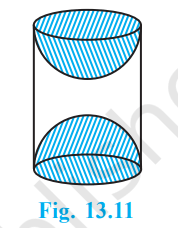
Radius of the cylinder = Radius of the hemispheres Curved Surface area of one hemisphere = 2πr2 = 2 × 22/7 × 3.5 × 3.5 = 77 cm2 Curved Surface area of the cylinder = 2πrh = 2 × 22/7 × 3.5 × 10 = 220 cm2 Total Surface Area of the given solid = 2 × CSA of one hemisphere + CSA of the cylinder = 2 × 77 + 220 = 154 + 220 = 374 cm2 Exercise 13.2Unless stated otherwise, take π = 22/7 1. A solid is in the shape of a cone standing on a hemisphere with both their radii being equal to 1 cm and the height of the cone is equal to its radius. Find the volume of the solid in terms of π. Solution 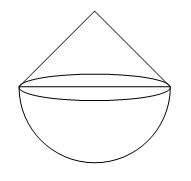
Volume of the cone = 1/3 × πr2h = 1/3 × 22/7 × 12 × 1 = 22/21 cm3 Volume of the hemisphere = 2/3 × πr3 = 2/3 × 22/7 × 13 = 44/21 cm3 Total volume of the given solid = Volume of Cone + Volume of Hemisphere = 22/21 + 44/21 = 66/21 = 22/7 = π cm3 2. Rachel, an engineering student, was asked to make a model shaped like a cylinder with two cones attached at its two ends by using a thin aluminium sheet. The diameter of the model is 3 cm and its length is 12 cm. If each cone has a height of 2 cm, find the volume of air contained in the model that Rachel made. (Assume the outer and inner dimensions of the model to be nearly the same.) Solution 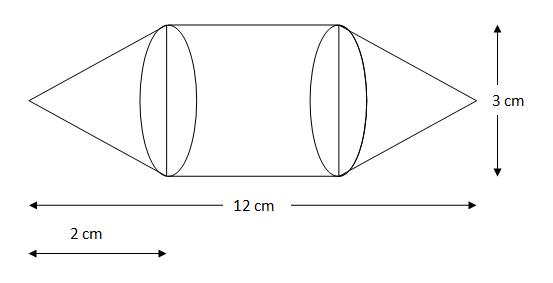
Radius of cylinder = Radius of cones = 3/2 = 1.5 cm Length of the cylinder = H = 12 - 2 - 2 = 8 cm Volume of one cone = 1/3 × πr2h = 1/3 × 22/7 × 1.5 × 1.5 × 2 = 33/7 cm3 Volume of the cylinder = πr2H = 22/7 × 1.5 × 1.5 × 8 = 396/7 cm2 Total volume of the model = Volume of Cylinder + 2 × Volume of Cone = 396/7 + 2 × 33/7 = 396/7 + 66/7 = 462/7 = 66 cm3 3. A gulab jamun, contains sugar syrup up to about 30% of its volume. Find approximately how much syrup would be found in 45 gulab jamuns, each shaped like a cylinder with two hemispherical ends with length 5 cm and diameter 2.8 cm (see Fig. 13.15). 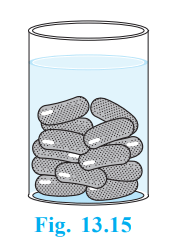
Solution 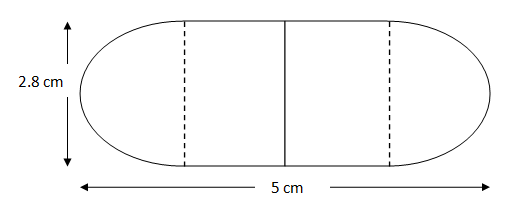
Radius of both hemispherical ends = Radius of cylinder = 2.8/2 = 1.4 cm Volume of the cylindrical part = πr2h = 22/7 × 1.42 × (5 - 1.4 - 1.4) = 22 × 0.28 × 2.2 = 13.552 cm3 Volume of on hemispherical end = 2/3 × πr3 = 2/3 × 22/7 × 1.43 = 17.248/3 cm3 Volume of one gulab jamun = 2 × Volume of one hemispherical end + Volume of cylindrical part = 2 × 17.248/3 + 13.552 = 34.496/3 + 13.552 = (34.496 + 40.656)/3 = 75.152/3 cm3 Volume of the sugar syrup in one gulab jamun = 30/100 × 75.152/3 = 7.5152 cm3 Volume of sugar syrup in 45 gulab jamuns = 7.5152 × 45 = 338.184 cm3 4. A pen stand made of wood is in the shape of a cuboid with four conical depressions to hold pens. The dimensions of the cuboid are 15 cm by 10 cm by 3.5 cm. The radius of each of the depressions is 0.5 cm and the depth is 1.4 cm. Find the volume of wood in the entire stand (see Fig. 13.16). 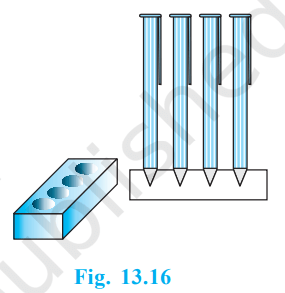
Solution Volume of the cuboid = l × b × h = 15 × 10 × 3.5 = 525 cm3 Volume of one conical depression = 1/3 × πr2h = 1/3 × 22/7 × 0.52 × 1.4 = 1.1/3 cm3 Volume of wood in the pen stand = Volume of cuboid - 4 × Volume of conical depression = 525 - 4.4/3 = (1575 - 4.4)/3 = 1570.6/3 = 523.533 cm3 5. A vessel is in the form of an inverted cone. Its height is 8 cm and the radius of its top, which is open, is 5 cm. It is filled with water up to the brim. When lead shots, each of which is a sphere of radius 0.5 cm are dropped into the vessel, one-fourth of the water flows out. Find the number of lead shots dropped in the vessel. Solution 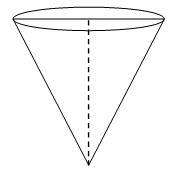
Volume of the water in the cone = Volume of the cone = 1/3 × πRr2h = 1/3 × 22/7 × 52 × 8 = 4400/21 cm3 Volume of water flown out of the vessel = 1/4 × 4400/21 = 1100/21 cm3 Volume of one lead shot = 4/3 × πr3 = 4/3 × 22/7 × 0.53 = 11/21 cm3 Number of lead shots dropped in the vessel = Volume of water flown out/Volume of one lead shot = 1100/21 × 21/11 = 100 Hence, 100 lead shots were dropped in the vessel. 6. A solid iron pole consists of a cylinder of height 220 cm and base diameter 24 cm, which is surmounted by another cylinder of height 60 cm and radius 8 cm. Find the mass of the pole, given that 1 cm3 of iron has approximately 8g mass. (Use π = 3.14) Solution 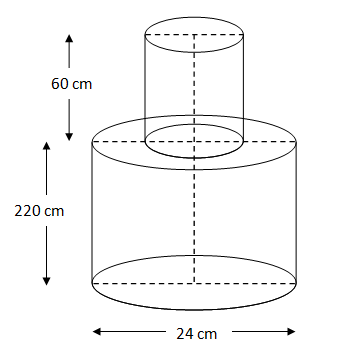
Volume of the cylinder on top = πr2h = 3.14 × 82 × 60 = 12057.6 cm3 Volume of the cylinder on bottom = πR2H = 3.14 × (24/2)2 × 220 = 99475.2 cm3 Volume of the iron pole = Volume of the cylinder on top + Volume of the cylinder on bottom = 12057.6 + 99475.2 = 111532.8 cm3 Mass of 1 cm3 of iron = 8g Mass of the iron pole = 111532.8 × 8 = 892262.4 cm3 7. A solid consisting of a right circular cone of height 120 cm and radius 60 cm standing on a hemisphere of radius 60 cm is placed upright in a right circular cylinder full of water such that it touches the bottom. Find the volume of water left in the cylinder, if the radius of the cylinder is 60 cm and its height is 180 cm. Solution 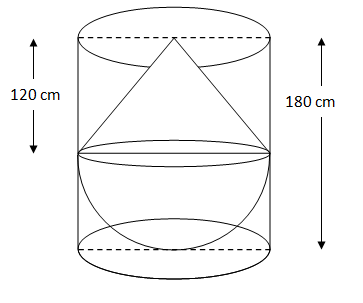
Volume of water in the cylinder = Volume of cylinder = πr2H = 22/7 × 602 × 180 = 14256000/7 cm3 Volume of the cone = 1/3 × πr2h = 1/3 × 22/7 × 602 × 120 = 3168000/7 cm3 Volume of the hemisphere = 2/3 × πr3 = 2/3 × 22/7 × 603 = 3168000/7 cm3 Volume of the water left in the cylinder = Volume of cylinder - Volume of the cone - Volume of the hemisphere = 14256000/7 - 3168000/7 - 3168000/7 = 7920000/7 cm3 or 7.92/7 m3 8. A spherical glass vessel has a cylindrical neck 8 cm long, 2 cm in diameter; the diameter of the spherical part is 8.5 cm. By measuring the amount of water it holds, a child finds its volume to be 345 cm3. Check whether she is correct, taking the above as the inside measurements, and π = 3.14. Solution 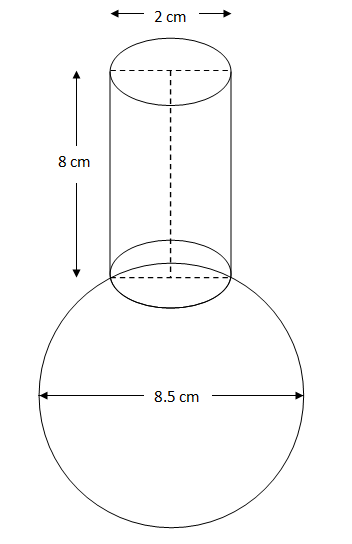
Radius of the cylindrical neck = 2/2 = 1 cm Volume of the cylinder = πr2h = 3.14 × 12 × 8 = 25.12 cm3 Radius of the spherical part = 8.5/2 = 4.25 cm Volume of the sphere = 4/3 × πR3 = 4/3 × 3.14 × 4.253 = 964.17625/3 cm3 Total volume of the vessel = Volume of the cylinder + Volume of the sphere = 25.12 + 964.17625/3 = (75.36 + 964.17625)/3 = 1039.54625/3 = 346.51 cm3 Hence, the child is incorrect. The correct volume is 346.51 cm3. Exercise 13.3Take π = 22/7, unless stated otherwise. 1. A metallic sphere of radius 4.2 cm is melted and recast into the shape of a cylinder of radius 6 cm. Find the height of the cylinder. Solution Volume of the metallic sphere = 4/3 × πr3 = 4/3 × π × 4.23 = 98.784π cm3 Since, the sphere was recast into the cylinder. Therefore, the volume will remain the same. Volume of cylinder = 98.784π πR2h = 98.784π 62 × h = 98.784 36h = 98.784 h = 2.744 cm Hence, the height of the cylinder is 2.744 cm. 2. Metallic spheres of radii 6 cm, 8 cm and 10 cm, respectively, are melted to form a single solid sphere. Find the radius of the resulting sphere. Solution Volume of the first sphere = 4/3 × πr13 Volume of the second sphere = 4/3 × πr23 Volume of the third sphere = 4/3 × πr33 Since, all three spheres were recast into the one. Therefore, volume of the constituting sphere will be equal to the sum of the volume of constituent spheres. Volume of the resulting sphere = 4/3 × πr13 + 4/3 × πr23 + 4/3 × πr33 4/3 × πR3 = 4/3 × π(r13 + r23 + r33) R3 = 63 + 83 + 103 R3 = 216 + 512 + 1000 R3 = 1728 R = 12 cm Hence, radius of the resulting sphere is 12 cm. 3. A 20 m deep well with diameter 7 m is dug and the earth from digging is evenly spread out to form a platform 22 m by 14 m. Find the height of the platform. Solution Volume of the cylindrical well = πr2H Volume of the platform = l × b × h Since, the volume of earth dug from well is used to make the platform. Therefore, their volumes will be equal. πr2H = l × b × h 22/7 × 7/2 × 7/2 × 20 = 22 × 14 × h 35 = 14h 5/2 = h h = 2.5 m Hence, height of the platform is 2.5 m. 4. A well of diameter 3 m is dug 14 m deep. The earth taken out of it has been spread evenly all around it in the shape of a circular ring of width 4 m to form an embankment. Find the height of the embankment. Solution Volume of the cylindrical well = πr2H Volume of the embankment = πR2h Since, the volume of earth dug from the well is used to make the embankment. Therefore, their volumes will be equal. πr2H = πR2h 3/2 × 3/2 × 14 = 4/2 × 4/2 × h 126 = 16h 63/8 = h h = 7.875 m Hence, the height of the embankment is 7.875 m. 5. A container shaped like a right circular cylinder having diameter 12 cm and height 15 cm is full of ice cream. The ice cream is to be filled into cones of height 12 cm and diameter 6 cm, having a hemispherical shape on the top. Find the number of such cones which can be filled with ice cream. Solution Volume of the cylindrical container = πR2H = π × 12/2 × 12/2 × 15 = 540π cm3 Volume of one cone = 1/3 × πr2h = 1/3 × π × 6/2 × 6/2 × 12 = 36π cm3 Volume of the hemispherical part on the cone = 2/3 × πr3 = 2/3 × π × 6/2 × 6/2 × 6/2 = 18π cm3 Volume of ice cream in each ice cream cone = Volume of cone + Volume of hemisphere = 36π + 18π = 54π cm3 Number of ice cream cones that can be filled = Volume of container/Volume of ice cream in each ice cream cone = 540π/54π = 10 Hence, 10 ice cream cones can be filled with the ice cream in the container. 6. How many silver coins, 1.75 cm in diameter and of thickness 2 mm, must be melted to form a cuboid of dimensions 5.5 cm × 10 cm × 3.5 cm? Solution Volume of the one silver coin = πr2h = 22/7 × 1.75/2 × 1.75/2 × 0.2 = 0.48125 cm3 Volume of the cuboid = 5.5 × 10 × 3.5 = 192.5 cm3 Number of coins required = Volume of cuboid/Volume of one coin = 192.5/0.48125 = 400 Hence, it takes 400 silver coins to form the required cuboid. 7. A cylindrical bucket, 32 cm high and with radius of base 18 cm, is filled with sand. This bucket is emptied on the ground and a conical heap of sand is formed. If the height of the conical heap is 24 cm, find the radius and slant height of the heap. Solution Volume of sand = Volume of the bucket = πr2H = π × 182 × 32 = 10368π cm3 Volume of the conical heap = 1/3 × πR2h = 1/3 × π × R2 × 24 = 8πR2 cm3 Since, the sand from the bucket is used to make the conical heap. Therefore, the volume will remain the same. 10368π = 8πR2 1296 = R2 R = 36 cm Slant height of the conical heap = √(h2 + R2) = √(242 + 362) = √(576 + 1296) = √(1872) = 12√13 cm Hence, the radius of the conical heap is 36 cm and its slant height is 12√13 cm. 8. Water in a canal, 6 m wide and 1.5 m deep, is flowing with a speed of 10 km/h. How much area will it irrigate in 30 minutes, if 8 cm of standing water is needed? Solution Length of the canal covered by water in 1 hour = 10 km = 10000 m Length of the canal covered by water in 1 minute = 10000/60 m Length of the canal covered by water in 30 minutes = 10000/60 × 30 = 5000 m Breadth of the canal covered = 6 m Height of the canal covered = 1.5 m Volume of water flowing through the canal in 30 minutes = 5000 × 6 × 1.5 = 45000 m3 Volume of the area irrigated = Volume of water flown through the canal Irrigated Area × Height of water = 45000 A × 0.08 = 45000 A = 562500 m2 Hence, the water flowing through the canal will irrigate 562500 m2 of area in 30 minutes. 9. A farmer connects a pipe of internal diameter 20 cm from a canal into a cylindrical tank in her field, which is 10 m in diameter and 2 m deep. If water flows through the pipe at the rate of 3 km/h, in how much time will the tank be filled? Solution Length of the water flowing through the pipe in 1 hour = 3 km = 3000 m Volume of water flowing through the pipe in 1 hour = πr2H = π × 0.2/2 × 0.2/2 × 3000 = 30π m3 Volume of water flowing through the pipe in 1 minute = 30π × 1/60 = 0.5π m3 Volume of water required to fill the tank = Volume of the tank = πR2h = π × 10/2 × 10/2 × 2 = 50π m3 Time taken to fill the tank = Volume of tank/Volume of water flown in 1 minute = 50π/0.5π = 100 minutes Hence, it takes 100 minutes for the water flowing through the pipe to fill the given tank. Exercise 13.4Use π = 22/7 unless stated otherwise. 1. A drinking glass is in the shape of a frustum of a cone of height 14 cm. The diameters of its two circular ends are 4 cm and 2 cm. Find the capacity of the glass. Solution Upper radius = 4/2 = 2 cm Lower radius = 2/2 = 1 cm Volume of the glass = Volume of the frustum of the cone = 1/3 × π(r12 + r22 + r1r2)h = 1/3 × 22/7 × (22 + 12 + 2(1))14 = 1/3 × 22/7 × (4 + 1 + 2)14 = 22/3 × 7 × 2 = 308/3 cm3 Hence, capacity of the glass = 308/3 cm3 2. The slant height of a frustum of a cone is 4 cm and the perimeters (circumference) of its circular ends are 18 cm and 6 cm. Find the curved surface area of the frustum. Solution Circumference of the larger circular end = 2πr1 18 = 2πr1 r1 = 9/π cm Circumference of the smaller circular end = 2πr2 6 = 2πr2 r2 = 3/π cm Curved Surface area of the frustum of the cone = πl(r1 + r2) = π × 4 × (9/π + 3/π) = π × 4 × 12/π = 48 cm2 3. A fez, the cap used by the Turks, is shaped like the frustum of a cone (see Fig. 13.24). If its radius on the open side is 10 cm, radius at the upper base is 4 cm and its slant height is 15 cm, find the area of material used for making it. 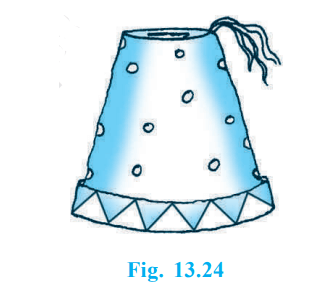
Solution Radius of the closed base = r1 = 4 cm Radius of the open base = r2 = 10 cm Curved surface area of the frustum = πl(r1 + r2) = 22/7 × 15 × (4 + 10) = 22/7 × 15 × 14 = 660 cm2 Area of the closed base = πr12 = 22/7 × 42 = 352/7 cm2 Area of the material required for making the cap = CSA of the frustum + Area of the closed base = 660 + 352/7 = (4620 + 352)/7 = 4972/7 cm2 Hence, 4972/7 cm2 of material is required to make the cap. 4. A container, opened from the top and made up of a metal sheet, is in the form of a frustum of a cone of height 16 cm with radii of its lower and upper ends as 8 cm and 20 cm, respectively. Find the cost of the milk which can completely fill the container, at the rate of Rs 20 per litre. Also find the cost of metal sheet used to make the container, if it costs Rs per 100 cm2. (Take π = 3.14) Solution Radius of the upper end = r1 = 20 cm Radius of the lower end = r2 = 8 cm Volume of milk which can completely fill the container = Volume of the frustum = 1/3 × πh(r12 + r22 + r1r2) = 1/3 × 3.14 × 16 × (202 + 82 + 20(8)) = 1/3 × 3.14 × 16 × (624) = 10449.92 cm3 = 10.44992 L Cost of 1 L of milk = Rs 20 Cost of 10.44992 L of milk = 20 × 10.44992 = Rs 208.9984 or Rs 209 Slant height of the container = l = √(h2 + (r1 - r2)2) = √(162 + (12)2) = √(256 + 144) = √(400) = 20 cm Curved surface area of the container = πl(r1 + r2) = 3.14 × 20 × (20 + 8) = 62.8 × 28 = 1758.4 cm2 Area of the base of the container = πr22 = 3.14 × 82 = 200.96 cm2 Area of metal required to make the container = CSA of the container + Area of the lower base = 1758.4 + 200.96 = 1959.36 cm2 Cost of 100 cm2 of metal sheet = Rs 8 Cost of 1 cm2 of metal sheet = 8/100 = Rs 0.08 Cost of 1959.36 cm2 of metal sheet = 0.08 × 1959.36 = Rs 156.7488 or Rs 157. Hence, the cost of milk required to fill the container is Rs 209 and cost of the metal sheet required to make the container is Rs 157 (Approx. values). 5. A metallic right circular cone 20 cm high and whose vertical angle is 60° is cut into two parts at the middle of its height by a plane parallel to its base. If the frustum so obtained be drawn into a wire of diameter 1/16 c, find the length of the wire. Solution 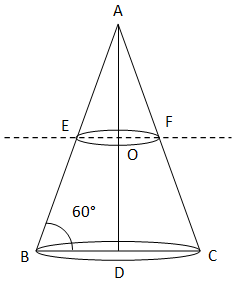
The cone was divided at the middle of its height. Therefore, AO = DO = 20/2 = 10 cm We know that ∠B and ∠C are 60°, this implies that ∠A = 180° - ∠B - ∠C (Sum of angles of ABC is 180°) ∠A = 180° - 60° - 60° ∠A = 60° ABC forms an equilateral triangle. Therefore, the perpendicular AD will bisect ∠A. ∠BAD = ∠CAD = 30° In ? AEO: tan 30° = EO/AO 1/√3 = EO/10 EO = 10/√3 cm In ? ABD: tan 30° = BD/AD 1/√3 = BD/20 BD = 20/√3 cm Radius of the larger circular end of frustum = r1 = 20/√3 cm Radius of the smaller circular end of frustum = r2 = 10/√3 cm Volume of the frustum = 1/3 × πh(r12 + r22 + r1r2) = 1/3 × π × 10((20/√3)2 + (10/√3)2 (20/√3) (10/√3)) = 1/3 × π × 10(400/3 + 100/3 + 200/3) = 1/3 × π × 10(700/3) = 7000π/9 cm3 Since, the frustum was drawn into the wire. Therefore, their volume will be equal. Volume of the cylindrical wire = Volume of the frustum πr2H = 7000π/9 1/32 × 1/32 × H = 7000/9 H = 7000/9 × 1024 H = 796444.44 cm or 7964.44 m Hence, the length of the wire is 7964.44 m. Exercise 13.5 (Optional)1. A copper wire, 3 mm in diameter, is wound about a cylinder whose length is 12 cm, and diameter 10 cm, so as to cover the curved surface of the cylinder. Find the length and mass of the wire, assuming the density of copper to be 8.88 g per cm3. Solution Radius of the cylinder = R = 10/2 = 5 cm Length of the wire required to complete one round of the cylinder = 2πR = 2 × 22/7 × 5 = 31.42 cm Diameter of the wire = 3 mm = 0.3 cm Number of rounds of wire required to cover 0.3 cm height of cylinder = 1 Number of rounds of wire required to cover 1 cm height of cylinder = 1/0.3 = 10/3 Number of rounds of wire required to cover 12 cm height of cylinder = 12 × 10/3 = 40 Length of the wire required to cover the CSA of the cylinder = Length of wire in one round × 40 = 31.42 × 40 = 1256 cm Volume of the wire = πr2H = 22/7 × 0.3/2 × 0.3/2 × 1256 = 88.81 cm3 Mass of the copper wire = Volume × Density = 88.81 × 8.88 = 788.63 grams 2. A right triangle, whose sides are 3 cm and 4 cm (other than hypotenuse) is made to revolve about its hypotenuse. Find the volume and surface area of the double cone so formed. (Choose value of π as found appropriate.) Solution 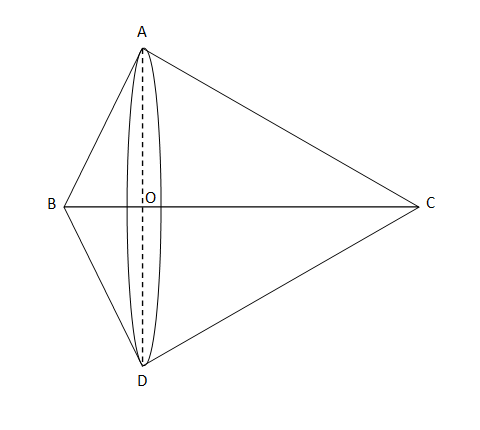
By applying Pythagoras Theorem in ABC, we get BC2 = AB2+ AC2 BC2 = 32 + 42 BC2 = 9 + 16 BC2 = 25 BC = 5 cm In ? ABC and ? AOC: ∠BAC = ∠AOC (Right Angles) ∠ACB = ∠ACO (Common Angles) Therefore, by the AA similarity criterion ? ABC ~ ? AOC. This implies that AB/AO = BC/AC (Corresponding sides of similar triangles) AO = AB × AC/BC AO = 3 × 4/5 = 12/5 cm Similarly, BO = AB2/BC BO = 32/5 = 9/5 cm CO = BC - BO = 5 - 9/5 = 16/5 cm Radius of the both cones = AO = DO = 12/5 cm Volume of the smaller cone = 1/3 × πr2h = 1/3 × 3.14 × 12/5 × 12/5 × 9/5 = 10.85 cm3 Volume of the larger cone = 1/3 × πr2H = 1/3 × 3.14 × 12/5 × 12/5 × 16/5 = 19.29 cm3 Volume of the double cones formed = 10.85 + 19.29 = 30.14 cm3 Curved Surface Area of the smaller cone = πrl = 3.14 × 12/5 × 3 = 22.6 cm2 Curved Surface Area of the larger cone = πrL = 3.14 × 12/5 × 4 = 30.14 cm2 Surface Area of the double cone formed = CSS of smaller cone + CSA of larger cone = 22.6 + 30.14 = 52.74 cm2 3. A cistern, internally measuring 150 cm × 120 cm × 110 cm, has 129600 cm3 of water in it. Porous bricks are placed in the water until the cistern is full to the brim. Each brick absorbs one-seventeenth of its own volume of water. How many bricks can be put in without overflowing the water, each brick being 22.5 cm × 7.5 cm × 6.5 cm? Solution Volume of the cistern when its completely empty = 150 × 120 × 110 = 1980000 cm3 Volume remaining after water is filled = 1980000 - 129600 = 1850400 cm3 Volume of one brick = 22.5 × 7.5 × 6.5 = 1096.875 cm3 Volume of water absorbed by one brick = 1096.875/17 cm3 Number of bricks required = (Remaining volume of cistern + Volume of water absorbed by one brick)/ Volume of one brick = (1850400 + 1096.875/17)/1096.875 ? 1792 Hence, 1792 bricks can be put into the cistern without overflowing the water in it. 4. In one fortnight of a given month, there was a rainfall of 10 cm in a river valley. If the area of the valley is 7280 km2, show that the total rainfall was approximately equivalent to the addition to the normal water of three rivers each 1072 km long, 75 m wide and 3 m deep. Solution Volume of water in one river = 1072 × 1000 × 75 × 3 = 241200000 m3 Volume of water in three rivers = 241200000 × 3 = 723600000 m3 Height of the rainfall = 10 cm = 0.1 m Volume of the water in the river valley due to the rainfall = Surface Area of the river valley × height of the rainfall = (7280 × 1000000) × 0.1 = 728000000 m3 Volume of the addition of normal water of the three rivers is 7.236 × 108 m3 while the volume of water in the river valley due to the rainfall is 7.28 × 108 m3. Therefore, they are approximately equal. Hence, proved. 5. An oil funnel made of tin sheet consists of a 10 cm long cylindrical portion attached to a frustum of a cone. If the total height is 22 cm, diameter of the cylindrical portion is 8 cm and the diameter of the top of the funnel is 18 cm, find the area of the tin sheet required to make the funnel (see Fig. 13.25). 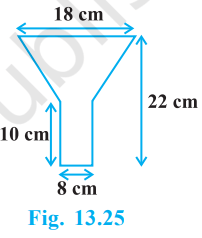
Solution Radius of the larger end of the frustum = r1 = 18/2 = 9 cm Radius of the smaller end of the frustum = r2 = 8/2 = 4 cm Height of the frustum portion of the funnel = H = 22 - 10 = 12 cm Slant height of the frustum l = √((r1 - r2)2 + H2) = √((9 - 4)2 + 122) = √(52 + 144) = √(25 + 144) = √169 = 13 cm Curved Surface Area of the frustum of the cone = π(r1 + r2)l = 22/7 × (9 + 4) × 13 = 22/7 × 13 × 13 = 3718/7 cm2 Radius of the cylindrical portion = r = 8/2 = 4 cm Curved Surface area of the cylinder portion = 2πrh = 2 × 22/7 × 4 × 10 = 1760/7 cm2 Area of tin sheet required to make the funnel = CSA of frustum + CSA of the cone = 3718/7 + 1760/7 = 5478/7 = 782.57 cm2 Hence, it will take 782.57 cm2 of tin sheet to make the funnel. 6. Derive the formula for the curved surface area and total surface area of the frustum of a cone, given to you in Section 13.5, using the symbols as explained. Solution 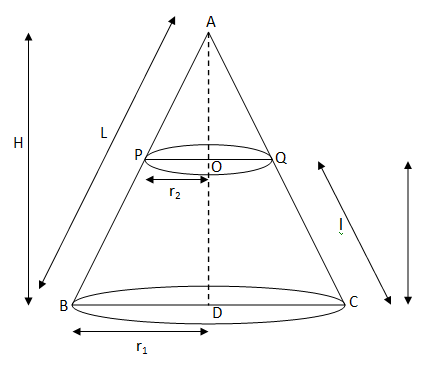
Let there be a cone ABC divided into the frustum PBCQ by the line PQ which is parallel to the base BC and cuts perpendicular AD of the cone at a point O. Consider the drawn figure. In ? AOP and ? ADB: ∠AOP = ∠ADB (Right Angles) ∠PAO = ∠BAD (Common Angle) Therefore, by the AA similarity criterion ? AOP ~ ? ADB. This implies that, PO/BD = AO/AD = AP/AB (Corresponding sides of similar triangles) r2/r1 = (H - h)/H = (L - l)/L r2/r1 = 1 - h/H = 1 - l/L Therefore, r2/r1 = 1 - l/L l/L = 1 - r2/r1 = (r1 - r2/r1) L = lr1/(r1 - r2) Curved Surface Area of cone ABC = πr1L Curved Surface Area of the cone APQ = πr2(L - l) Curved Surface Area of the frustum PBCQ = πr1L - πr2(L - l) = πr1 × (lr1/(r1 - r2)) - πr2 × (lr1/(r1 - r2) - l) = πr12l/(r1 - r2) - πr2 × (lr1 - lr1 + lr2)/(r1 - r2) = πr12l/(r1 - r2) - πr22l/(r1 - r2) = πl × (r12 - r22)/(r1 - r2) = πl × (r1 - r2)(r1 + r2)/(r1 - r2) = π(r1 + r2)l Total Surface Area of the frustum PBCQ = CSA + Area of upper base + Area of lower base = π(r1 + r2)l + πr22 + πr12 = π((r1 + r2)l + r12 + r22) Hence, derived the required formulas. 7. Derive the formula for the volume of the frustum of a cone, given to you in Section 13.5, using the symbols as explained. Solution 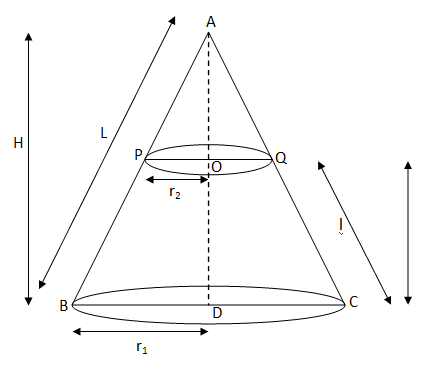
Let there be a cone ABC divided into the frustum PBCQ by the line PQ which is parallel to the base BC and cuts perpendicular AD of the cone at a point O. Consider the drawn figure. In ? AOP and ? ADB: ∠AOP = ∠ADB (Right Angles) ∠PAO = ∠BAD (Common Angle) Therefore, by the AA similarity criterion ? AOP ~ ? ADB. This implies that, PO/BD = AO/AD = AP/AB (Corresponding sides of similar triangles) r2/r1 = (H - h)/H = (L - l)/L r2/r1 = 1 - h/H = 1 - l/L Therefore, r2/r1 = 1 - h/H h/H = 1 - r2/r1 = (r1 - r2/r1) H = hr1/(r1 - r2) Volume of the cone ABC = 1/3 × πr12H Volume of the cone APQ = 1/3 × πr22(H - h) Volume of the frustum PBCQ = Volume of ABC - Volume of APQ = 1/3 × πr12H - 1/3 × πr22(H - h) = 1/3 × (πr12hr1/(r1 - r2) - πr22(hr1/(r1 - r2) - h)) = π/3 × (hr13/(r1 - r2) - r22(hr1 - hr1 + hr2)/(r1 - r2)) = π/3 × (hr13/(r1 - r2) - hr23/(r1 - r2)) = πh/3 × (r13 - r23)/(r1 - r2) = πh/3 × (r1 - r2)(r12 + r22 + r1r2)/(r1 - r2) = 1/3 × πh(r12 + r22 + r1r2) Hence, derived the required formula.
Next TopicClass 10 Maths Chapter 14
|
 For Videos Join Our Youtube Channel: Join Now
For Videos Join Our Youtube Channel: Join Now
Feedback
- Send your Feedback to [email protected]
Help Others, Please Share









